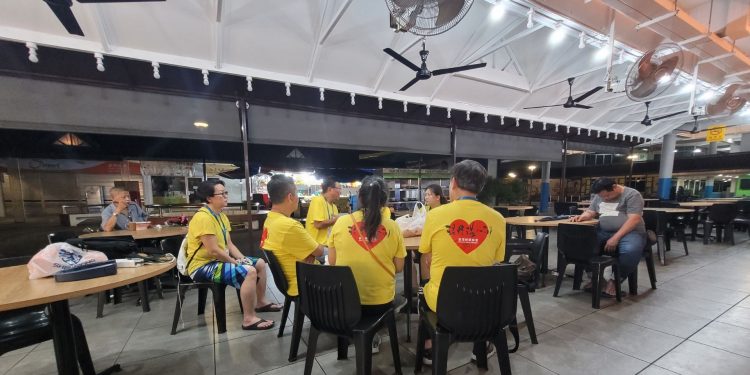In the popular American sitcom How I Met Your Mother, Ted Mosby, a character played by actor Josh Radnor, had a rule, “Nothing good ever happens after 2am”. He was speaking to his proclivity to make bad decisions past a certain time of day. Well, it sort of depends where you look.
If you were to look around the bars of Clarke Quay past a Friday midnight, you might find some bad decisions being made. But if you are the sort that is usually shuttered in your bed before 10pm, then the phrase might not bear much significance.
In the case of a group of volunteers in Ang Mo Kio, the saying does not hold water.
If you look hard enough past 2am across car parks, coffeeshops, and void decks, you might find some good being done for rough sleepers and the vulnerable in the community.
Findings from a 2019 research by the Lee Kuan Yew School of Public Policy on the first nationwide street count of homelessness in Singapore showed an estimate of between 921 and 1,050 street homeless people in Singapore. The research observed that homelessness occurred in most parts of Singapore. Most of the homeless people were older men while more homeless people were found in larger and older housing estates, and estates with more rental flats. The most common locations where homeless people slept were public housing void decks and commercial buildings.
In July that year, the Partners Engaging and Empowering Rough Sleepers (PEERS) Network was launched under the Ministry of Social and Family Development (MSF) “to build on the growing partnerships among community groups, social service and government agencies”. The PEERS Network helps to “empower, facilitate, and support community partners in providing assistance to rough sleepers and homeless individuals”.
There are over 50 partners within the network which participate in three initiatives – befriending, Safe Sound Sleeping Places (S3Ps), and night cafés.
During the Covid-19 pandemic, the plight of these rough sleepers were highlighted which saw a ramp up from the various communities like religious groups and volunteer organisations to help them.
A 2021 Straits Times article, written by research fellow at the Institute of Policy Studies Dr Harry Tan, noted the shift in approach.
“On the ground, a significant move from the traditional institutionalised approach to a community-based social work approach – one that relies more on social service agencies and community volunteers to engage with the homeless – is apparent” Dr Tan wrote.
Befriending rough sleepers through late night walks
“I teach my volunteers to use their hearts instead of their brains. If you want to help rough sleepers, you must treat them like your parents. If you want to do charity work, you cannot judge in terms of costs and worth. How big is your heart? I always fear my volunteers use too much of their brains but not their hearts. If you are a doctor, you don’t judge what someone has done. You just try to save their life. That’s our job. Our slogan is leave no one behind. Not even one,” says Mr Michael Sim.
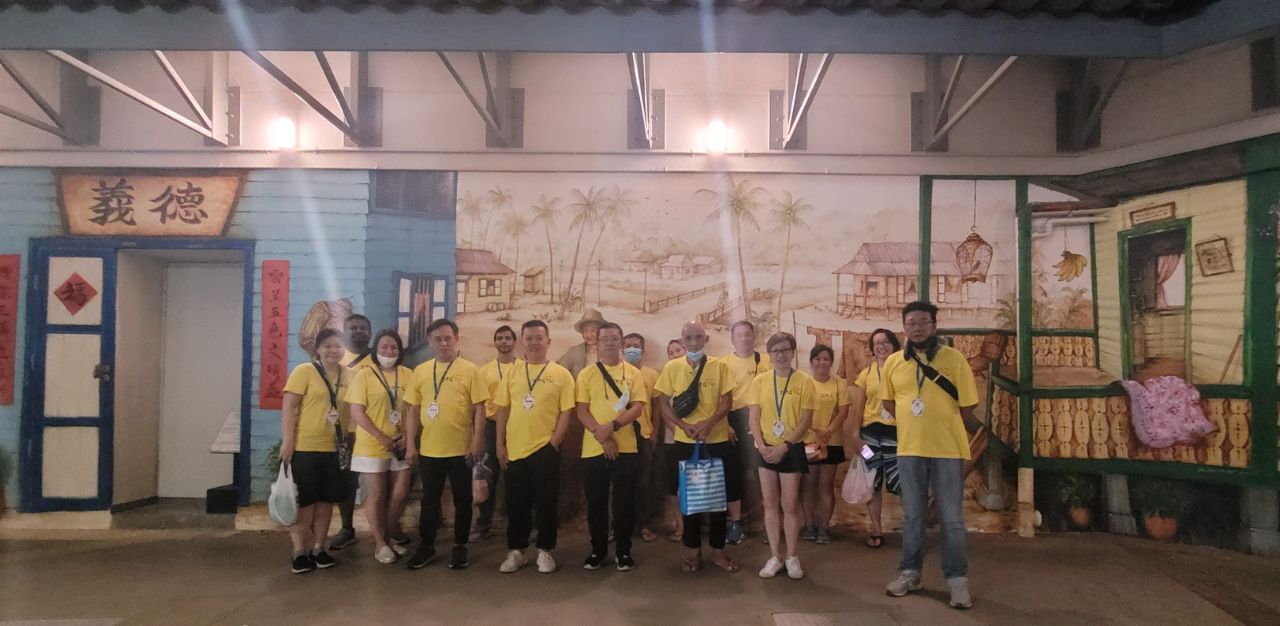
Mr Sim heads a volunteer group for rough sleepers under Gao Ling Gong Temple in Ang Mo Kio. The temple has been around for over 130 years and has deep roots in the community which it has been serving for many years, through programmes like social gatherings and food donations.
In 2020, Mr Sim and his volunteers wanted to help rough sleepers in the Ang Mo Kio region and joined the PEERS network as certified partners, but Mr Sim is quick to explain the value and differentiation of being affiliated with the temple.
“Even though we are under the name of the temple, we are a multi-racial and religious group of volunteers that promote the kampung spirit. We put the rough sleepers in the area first before our individual religious beliefs. Our temple has been around for over 130 years and is a recognisable landmark for many in Ang Mo Kio. We wear our yellow shirts with the temple logo to show that we are credible and committed to helping rough sleepers through our interaction with them and the public,” he adds.
On any given Saturday night after 10pm, Mr Sim and his group of 20 to 30 regular volunteers can be seen walking around the coffeeshops and void decks of Ang Mo Kio in their bright shirts to befriend rough sleepers.
Volunteer Agnes Ng, who assists Mr Sim in planning their ‘nightwalks’, says that this is the first step to trust and credibility with the rough sleepers.
“Many rough sleepers are initially very hesitant to talk to us. It’s usually because they are shy in seeking help. It was a learning curve for our group. Thankfully over time, after multiple visits with the rough sleepers, they’ve begun to trust us and share their struggles. It’s been about two years since we first started, and many of the rough sleepers are excited when we visit them on Saturday nights,” says the 55-year-old.
The group are in contact with about 50 to 80 rough sleepers in Ang Mo Kio, and will keep in touch with them throughout the week through the phone to check in on their locations and what they might need help with. When the volunteers visit on Saturday nights, they provide basic necessities and follow up on the help that the homeless need.
TheHomeGround Asia accompanied the volunteers on a nightwalk on 6 Aug, first gathering around Teck Ghee court at 10pm and splitting into groups before heading out.
A rough sleeping couple have been sleeping in an Ang Mo Kio car park for about a year and Mdm Ng says the couple had some set-backs over housing applications. Due to miscommunication with their social service officer, the couple became unsuccessful in a recent housing exercise. Mdm Ng says they used to visit washrooms at a local park to wash up, before the volunteers collaborated with a neighbouring Community Center (CC) to use their showering facilities.
In Dec 2021, the Joint Singles Scheme Operator-Run (JSS-OR) Pilot was launched to further support lower-income singles in need of rental housing. It allows singles to apply for rental housing without first having to find a flatmate. The pilot was launched to supplement the existing Joint Singles Scheme (JSS), under which two or more singles may jointly apply for a public rental flat.
Mr Sim says that most of the rough sleepers they are in contact with are on the waiting list for such housing schemes but he notes that many of them are in their current situation because of disagreements with family members and flat mates.
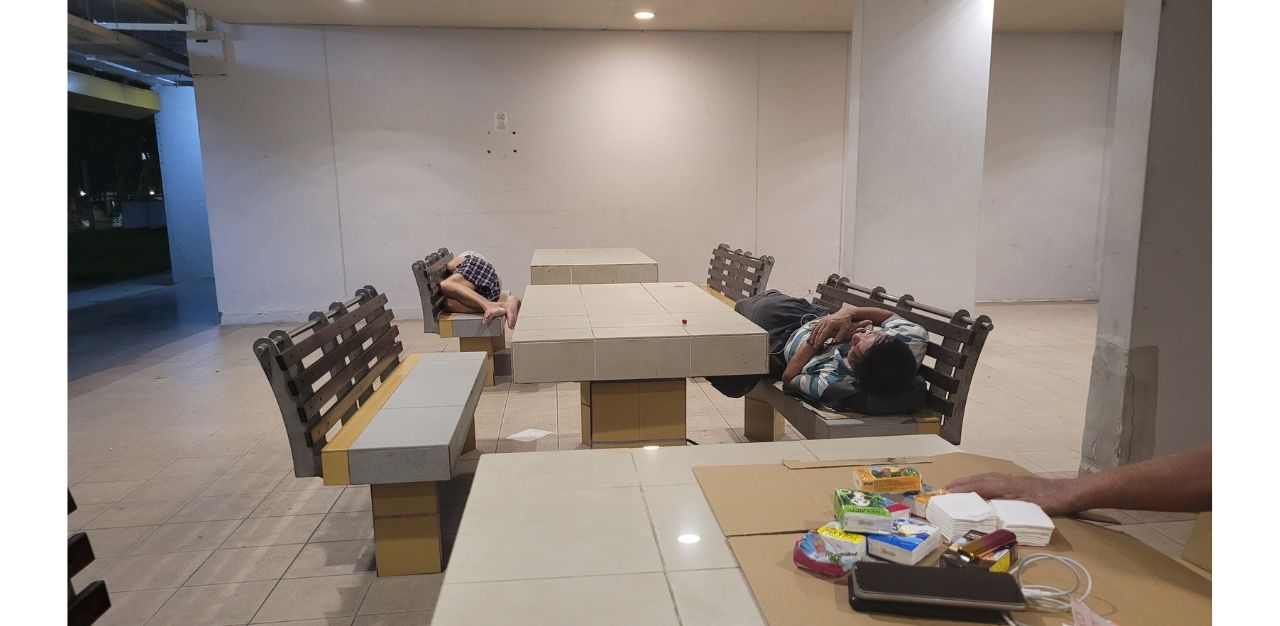
Rough sleeper Lim says he was couch surfing at a friend’s place but moved out because of a disagreement. He has been sleeping under different void decks in Ang Mo Kio for about three months while waiting to get paired up with another applicant for a rental unit. Mr Lim works irregular odd jobs when possible, such as cleaning or shopkeeping and earns about S$1,000 a month. He says that he still manages to keep his belongings in the home of another friend.
The volunteers proposed to the social service office (SSO) to provide facilities like lockers for rough sleepers so that they can secure their belongings. Mdm Ng adds that rough sleepers tend to store items and valuables in places like electrical boxes while they are at work.
Another rough sleeper that the group visited was sleeping near the back entrance of a shop in a low rise HDB shop house. He says he divorced his wife in 1988 and his children live around the area.
Mdm Ng says that his children had wanted their father to live with them but he chose not to as he did not want to impose on them. The rough sleeper is working as a cardboard collector and had received complaints from neighbours for storing his cardboards around the area. The volunteers worked with the SSO to seek permission for the town council to have a designated area for him to store his cardboards. Mdm Ng adds that workers in a nearby coffee shop also help to look after him.
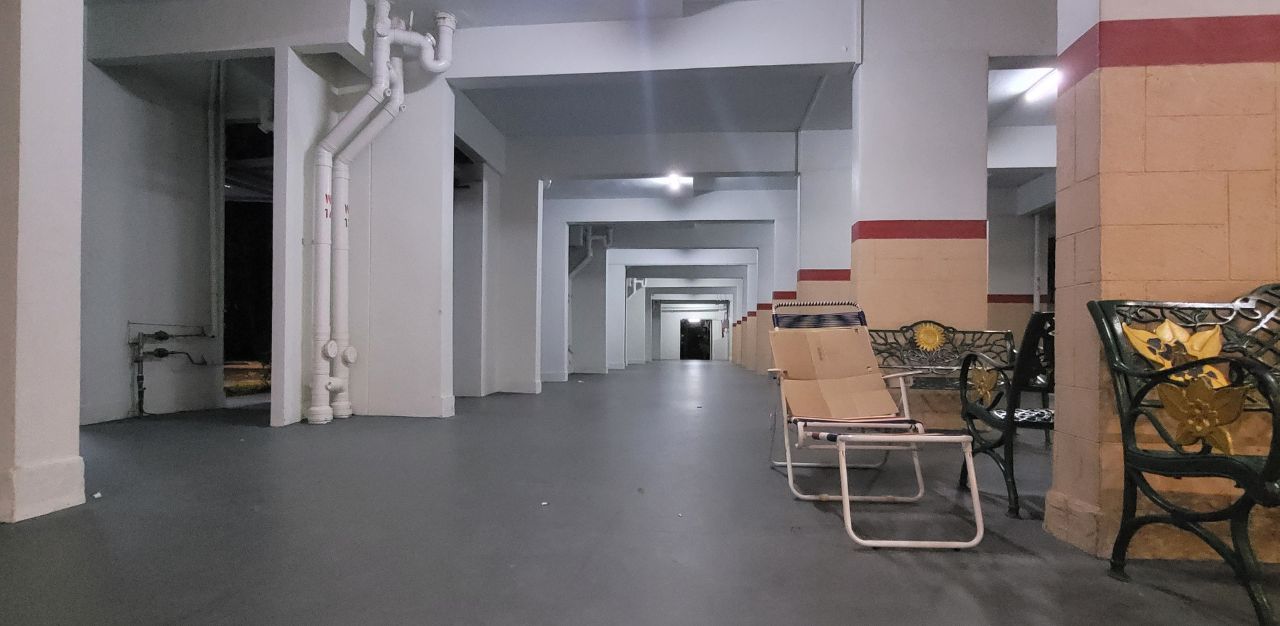
This sense of community is ultimately what Mr Sim and his volunteers are trying to promote.
“When we approach any rough sleepers, we will ask them which kampung they come from. So we will see if we have any links through mutual friends and this makes it easier to strike up a conversation. This is our approach,” he says.
From kampungs to school to streets
“There used to be a rough sleeper at the coffeeshop at blk 603 with whom we were in touch. He is in a nursing home now, but we continue to go around to meet the stallowners at the coffeeshop. They also provide free meals every Tuesday to anyone in need. I think through all these ground efforts, the community has seen what we are trying to do, and they are chipping in to help. It’s the kampung spirit that we are trying to build up,” says volunteers See Lay Khim and Lim Pei Shi.
“The regular walkers are between 20 to 30, but we have a wider supporting group of about 60 to 70 to help. Residents are another important asset. Around the places where we usually walk, we make friends with the residents and they call us to provide information should there be a rough sleeper around their house that we can engage with. They actively approach us. It’s very important because they are also the eyes and ears on the ground,” the pair adds.
Ms See and Ms Lim volunteer weekly and are also alumni of Ang Mo Kio secondary school, where they started volunteering with Mr Sim.
“I met him at a 40th anniversary event. After that I saw a Facebook post asking for volunteers and I responded. I started volunteering during the circuit breaker in 2020 when we delivered meals to needy elderies who were stuck at home. After helping out in such events, I eventually got involved in the nightwalks,” says Ms Lim.
“We don’t have a volunteer or cash problem, I can post on Facebook and have a whole group of alumni come down. That’s why bonding and the kampung spirit is so important. For the elderly and needy, they tend to meet at public spaces like markets and coffee shops. I feel that the reason why we manage to engage the elderly successfully is because we know everyone who hangs out at the coffee shop. They are the ones who tell us where some rough sleepers are or who is in need of help. They are the unsung heroes who contribute a lot to our nightwalks. That’s why we gather at coffee shops and walk around these areas,” says Mr Sim.
Mr Sim says that he is trying to get a shelter set up in Ang Mo Kio that is as accessible as possible. He cites an example of a female rough sleeper who sleeps in a particular area as she feels the nearest women’s shelter in Punggol is inconvenient for her due to her handicap.
“In general, rough sleepers around Ang Mo Kio want to stay in Ang Mo Kio. The main reason is friends. They are also familiar with the area so they want to stay put . Alot of them are waiting to get a rental unit in Ang Mo Kio, so they rough sleep in the area until one opens up,” he says.
Mdm Ng also says there is a rough sleeper who would rather remain sleeping rough as the staying at a temporary shelter around the area is only short term.
Mr Sim says that authorities like the SSO are fundamental in helping as they can conduct screenings of profiles to help them have a better understanding of a rough sleeper.
In the meantime, the group is focused on maintaining its relationship with the rough sleepers, helping them where possible, and building the kampung spirit.
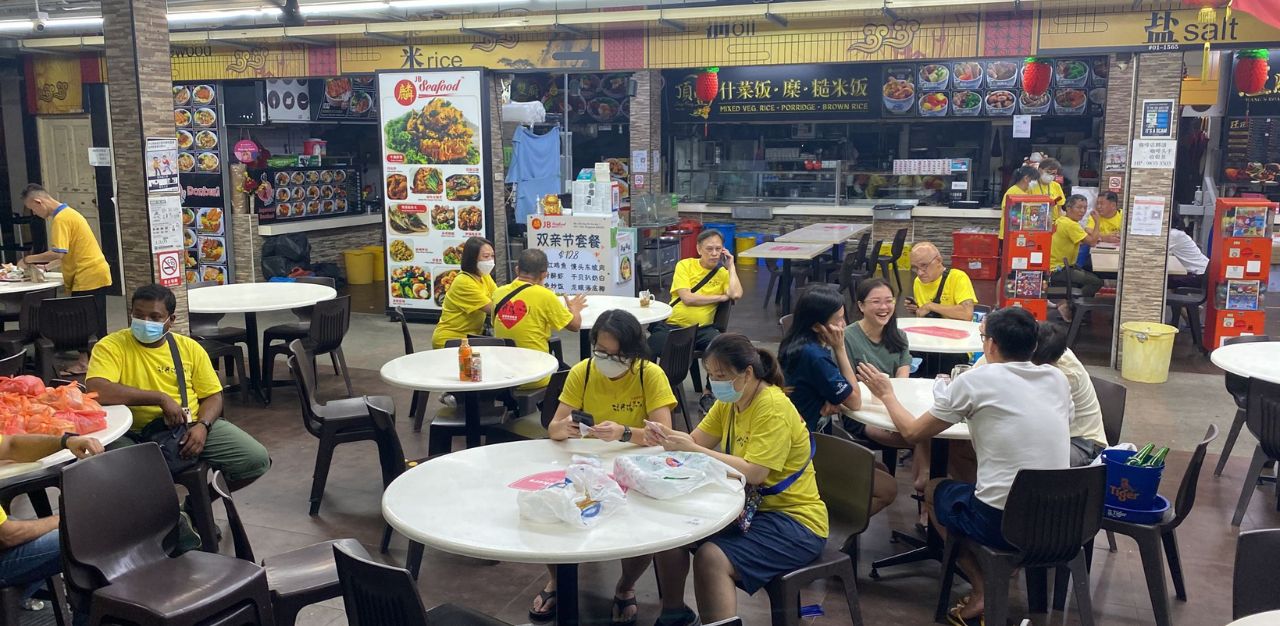
“The gates are always open to neighbours. If today you fight with your wife, you can stay at your neighbour’s house to cool down. My version of the kampung spirit is when someone gets into trouble, it’s only natural in the kampung to offer a home to the homeless. There’s no shame. There are only rainy days. The whole community comes together to help. The whole kampung is out searching for you, they want you to be found. We hope that this spirit will carry on, especially with the younger generation to keep this alive,” he says.
He says that his personal experience from such ties fostered in the kampung is what keeps him motivated to help rough sleepers and the vulnerable in his community of Ang Mo Kio.
“When my father died, and as I stood beside his coffin, a lot of the people from the kampung came and told me how my father used to help them and it meant a lot to me.”
RELATED: Reviving the Kampung Spirit in Sengkang through food rescue
Join the conversations on TheHomeGround Asia’s Facebook and Instagram, and get the latest updates via Telegram.



